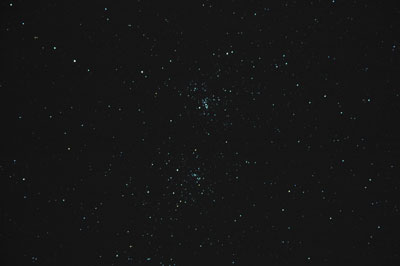Perseus is not a particularly eye-catching constellation, but it is in an interesting part of the Milky Way. Several novae were observed in it. For example, in February 1901 a nova appeared between β and δ Persei, which reached 0.2m. Particularly in the region around η Persei you can track the course of dark clouds which attenuate the light of more distant stars – if your eyes are adapted to the darkness and, of course, if you can see the Milky Way at all.
Around α Persei, you can find the stars of the star cluster Melotte 20, which is also known as α-Persei-Moving-Group. α Persei itself bears the names Mirfak and Algenib. It is a 590 light-years distant star. The Persei association includes about 70 stars to the tenth magnitude, which are distributed around the bright Mirfak. In binoculars, an area with 3° in diameter appears full of stars. The central region of Melotte 20 measures about 33 light-years, the entire group is about 550 light-years away. α Persei is the brightest member of the 50 million year old association.
β Persei is better known as Algol, the “Demon Star in Perseus”. The 93 light-years distant star system is probably the best known eclipsing binary. Every 2.87 days the larger but less luminous star obscures its lighter and smaller companion. For ten hours then the brightness decreases from 2.1 to 3.4m. When the larger star is behind the brighter star a half turn later, there is a smaller decrease in brightness. Although the brightness fluctuations were already known to the Arab astronomers, John Goodricke was the first to recognize the regularity of the light curve in 1782.
The brighter component is a 2.6 million mile (4.2 million kilometer) large star with 3.5 to 4 solar masses and one hundred times the solar luminosity. With a diameter of 3.1 million miles (5 million km) its only slightly larger companion is just about as bright and massive as our Sun. The two stars are only 6.2 million miles (10 million kilometers) apart, so there probably is an exchange of gas masses between them. The stars also shed light on each other so that they show phases similar to our Moon, which are also reflected in the light curve. At least one more star belongs to Algol – in older literature five stars were allotted to the system.
ζ Persei is located 8° north of the Pleiades and marks the center of the Perseus II association, the second largest star association in Perseus. It contains twenty stars that are visible to the naked eye and has a diameter of 100 light-years. It is also known as Perseus OBII Group and is only a million years old. It contains a lot of young, hot stars that depart with 7.6 miles per second (12 km/s) from each other. Among the members of the 1,000 light-years distant association are ο and ξ Persei. Remnants of the origin nebula may still be seen with averted vision. Most striking is the California-Nebula NGC 1499, which can be seen in 10 × 50 binoculars with averted vision when it is high in the sky. With 145 × 40 minutes of arc, it is very large, so it was only discovered in 1885 by Edward E. Barnard on photographs. UHC filters show it much better, but in a normal pair of binoculars it is a difficult target at best.
M 34 is an open cluster of about 80 stars between seventh and thirteenth magnitude that can be seen with the naked eye under good conditions at the border to Andromeda. The cluster is only loosely focused and with a diameter of 35 arcmin slightly larger than the full Moon. The 1,400 light-years distant cluster has a diameter of 15 light-years. In its center is a small accumulation of about 20 stars. Their diameter is about four light-years, so the stars would fit almost exactly between the Sun and its nearest neighboring star, α Centauri.
h and χ Persei (NGC 869, NGC 884) are the most famous and beautiful pair of star clusters. To the naked eye they appear as nebulae, while a pair of binoculars can resolve them fine. Each of the more than full Moon big star clusters contain about 300 stars, they meld with the stars of the 8 × 6° wide Perseus OB1 association – an impressive sight. The Perseus OB1 association is the namesake for our neighboring outer spiral arm of the Milky Way, the Perseus arm.

The two clusters each have a diameter of about 60 light-years and are 7,000 light-years away – so they are in fact neighbors. NGC 869 contains 3,900 solar masses and was created 5.6 million years ago, while NGC 884 with 3,300 solar masses and an age of 3.1 million years is smaller and younger. Despite their different ages they were created from parts of the same cloud of gas. Both clusters consist mainly of blue stars but also contain quite a few older, reddish stars.
Trumpler 2 is at 10 x 20 arcminutes significantly smaller than h and χ Persei 2.5° to the northwest. About ten stars of this 1,900 light-years distant open cluster can be resolved in binoculars. They form a chain through the center of the star cluster. Trumpler 2 is 78 million years old and has a diameter of 11 light-years.
